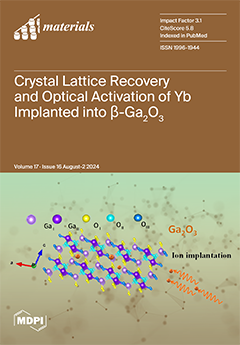Lab-made biosilica (SiO
2) nanoparticles were obtained from waste biomass (rice husks) and used as eco-friendly fillers in the production of nickel matrix composite films via the co-electrodeposition technique. The produced biosilica nanoparticles were characterized using XRD, FTIR, and FE-SEM/EDS. Amorphous nano-sized biosilica particles with a high SiO
2 content were obtained. Various current regimes of electrodeposition, such as direct current (DC), pulsating current (PC), and reversing current (RC) regimes, were applied for the fabrication of Ni and Ni/SiO
2 films from a sulfamate electrolyte. Ni films electrodeposited with or without 1.0 wt.% biosilica nanoparticles in the electrolyte were characterized using FE-SEM/EDS (morphology/elemental analyses, roundness), AFM (roughness), Vickers microindentation (microhardness), and sheet resistance. Due to the incorporation of SiO
2 nanoparticles, the Ni/SiO
2 films were coarser than those obtained from the pure sulfamate electrolyte. The addition of SiO
2 to the sulfamate electrolyte also caused an increase in the roughness and electrical conductivity of the Ni films. The surface roughness values of the Ni/SiO
2 films were approximately 44.0%, 48.8%, and 68.3% larger than those obtained for the pure Ni films produced using the DC, PC, and RC regimes, respectively. The microhardness of the Ni and Ni/SiO
2 films was assessed using the Chen-Gao (C-G) composite hardness model, and it was shown that the obtained Ni/SiO
2 films had a higher hardness than the pure Ni films. Depending on the applied electrodeposition regime, the hardness of the Ni films increased from 29.1% for the Ni/SiO
2 films obtained using the PC regime to 95.5% for those obtained using the RC regime, reaching the maximal value of 6.880 GPa for the Ni/SiO
2 films produced using the RC regime.
Full article






